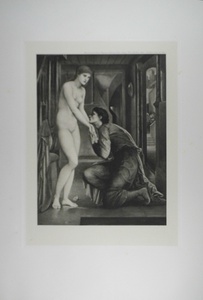| Method | Photogravure |
| Artist | after Sir Edward Coley Burne-Jones |
| Published | Published by the Berlin Photographic Company Berlin. _ London W.133 New Bond Street. _ New York 14 East 23rd Street. [c.1900] |
| Dimensions | Image 282 x 217 mm, Plate 347 x 268 mm, Sheet 667 x 507 mm |
| Notes |
Printed on India laid paper. Plate 21, taken from Burne-Jones' 1878 oil painting of the same title, from 'The Work of Edward Burne-Jones, Ninety-One Photogravures Directly Reproduced from the Original Paintings'. Only two-hundred copies of the 'The Work of Edward Burne-Jones...' were produced, each of which was signed by Philip Burne-Jones, the eldest son of Edward. Burne-Jones' 'The Soul Attains' was the final painting of a series of four titled 'Pygmalion and the Image'. The well-known tale, from Ovid's 'Metamorphoses' witnesses Pygmalion, a Cypriot sculptor, swear an oath of celibacy in disgust at the local women's debaucherous lifestyles. Unable to find a woman to marry, Pygmalion sculpts an ivory statue of his ideal woman. Having fallen in love with his creation, Pygmalion asks Aphrodite to send him a woman that resembles the statue. Aphrodite answers his prayers by bringing the statue to life. She becomes known as Galatea, whom Pygmalion marries. 'The Soul Attains' depicts the final stage of the Pygmalion myth. Here, Pygmalion kneels at the feet of Galatea, Pygmalion's statue that has been given life. Although Pygmalion gazes up at her adoringly, and she passes her hands to him, Galatea's stare is fixed in the distance. Like many women featured in Burne-Jones' paintings, Galatea evokes an air of mystery. Burne-Jones painted two series with the title 'Pygmalion and the Image'. The painting from which this photogravure was taken is from the second series, which is held in the collection of the Birmingham Museum and Art Gallery. Currently, the first series is in the collection of Lord Lloyd-Webber. The figure of Pygmalion in the second series is said to have been modelled of W A S Benson, a leading designer of the Arts and Crafts movement. Sir Edward Coley Burne-Jones, 1st Bt (1833-1898) was a painter and designer closely associated with the later phase of the Pre-Raphaelite movement. Burne-Jones met William Morris as an undergraduate of Exeter College, Oxford, whilst studying for a degree in theology. The pair went on to work very closely together on numerous decorative arts projects including stained glass windows, tapestries, and illustrations. Originally intending to become a church minister, Burne-Jones never finished his degree, choosing instead to pursue an artistic career under the influence of Dante Gabriel Rossetti. Rossetti heavily inspired his early work, but by the 1860's his idiosyncratic style was beginning to develop. His mature work, however different in total effect, is rich in conscious echoes of Botticelli, Mantegna and other Italian masters of the Quattrocento. Thusly, Burne Jones' later paintings of classical and medieval subjects are some of the most iconic of the Pre-Raphaelite movement. He was at the height of his popularity during the 1880's, though his reputation began to decline with the onset of the Impressionists. He was created a baronet in 1894, when he formally hyphenated his name. The Berlin Photographic Company, (1880 - 1920; fl) or the Berlin Photographische Gesellschaft, was a German print publishers who specialised in photogravures after Old Masters and contemporary painters. High quality photographs were taken of the original works. The negatives were then exposed onto a gelatin covered copper plate, etched with acid, and printed in a similar fashion to an engraving. The main series of the Berlin Photographic Company's publications is kept together at Blythe House, West Kensington. Condition: Foxing and discolouration to margins, water stains to upper right and lower left corners of sheet, not affecting image. |
| Framing | unmounted |
| Price | £450.00 |
| Stock ID | 41482 |

